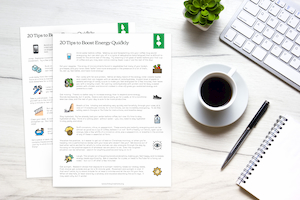Today’s post features a few key takeaways from a recent Wellness Your Way podcast interview. Find the full episode here and be sure to subscribe to Wellness Your Way so you don’t miss future episodes!
Guest Bio: Dr. Morgan Nolte
Dr. Morgan Nolte is the founder of Zivli, LLC. After earning her DPT from the University of Nebraska Medical Center, she completed the Creighton University-Hillcrest Health Systems Geriatric Physical Therapy Residency Program. Outside of work, she loves cheering on the Nebraska Cornhuskers, spending time with her family, reading, exercising, and being active outside.
Top Insights from Dr. Morgan Nolte’s Interview
- Insulin is a vital hormone made in the pancreas. Everyone except those with Type 1 diabetes makes insulin (and those with Type 1 diabetes require insulin injections). The term “insulin resistance” (which goes along with type 2 diabetes) doesn’t mean you no longer make insulin, but rather that your body makes a lot of insulin because you’ve become resistant to its effect.
- Insulin plays many roles in the body. The most common role is blood sugar regulation. When you eat, blood sugar goes up and insulin is released to push blood sugar into the cells to maintain a stable level, ideally between 70-100.
- Insulin resistance occurs when your body becomes resistant to the effects of insulin. This means your body has a harder time controlling your blood sugar balance. More and more insulin has to be released from the pancreas to keep blood sugars in a normal range.
- Every cell in the body has an insulin receptor. Because of this, insulin resistance affects not just one part of the body but everything. As more and more cells become unable to use this critical hormone, they experience decline and loss of function.
- Having a normal A1C or normal blood sugar doesn’t mean you don’t have an insulin problem. It’s important to test fasting insulin levels to see what’s going on in the body. Fasting insulin isn’t normally included on regular blood panels.
- Insulin resistance is on the rise. Possible reasons could include testing becoming easier, a diet high in processed foods, refined starches, and sugars, any form of stress, sleep deprivation, physical inactivity, not making health a priority, etc.
- Insulin resistance has a gradual onset. Because of this, there may not be many symptoms people notice. Some of the very first signs and symptoms can include fatigue, carb cravings, skin tags, weight gain, and brain fog.
- Insulin resistance and non-alcoholic fatty liver disease are linked by fructose. When we eat a diet high in fructose, whether natural or added, it is almost exclusively metabolized in the liver. When there’s more fructose than the liver can metabolize, it’s turned into fat and stored until it can be used. To learn about non-alcoholic fatty liver disease, see Megan’s post here.
Want to hear the full episode including how to treat insulin resistance, why movement after meals is so important, how reducing sugar is beneficial for the body and so much more?
Head over here to catch the full episode with Dr. Morgan Nolte!
Now it’s your turn! What is one thing you learned from this interview?
️ Want to hear about this topic in audio format? → Check out the podcast episode here!




I completely changed my diet for several years now and my BP won’t budge.